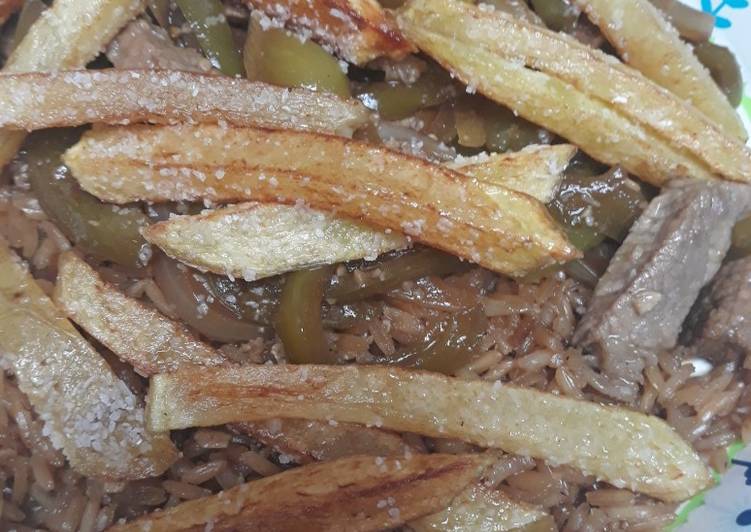Lomo Saltado. Season the steak with salt, pepper and garlic, to taste. In a deep-fryer or heavy-bottomed pot, heat enough oil to come halfway up the sides. Lomo Saltado is perhaps the most famous dish representing the genre and the name literally translates to "jumped loin." "Lomo," or loin, is a reference to the cut of meat that's typically used. "Saltado," on the other hand is a reference to the cooking technique, as stir-frying involves "jumping" the ingredients around the pan.
 However, its origins are definitely more Chinese than Inca!.
Lomo saltado is almost like a metaphor for modern-day culture: key ingredients from different corners of the world that combine to create something new and characteristic.
This blending helped the dish acquired a whole new identity of its own.
You can have Lomo Saltado using 26 ingredients and 8 steps. Here is how you cook it.
However, its origins are definitely more Chinese than Inca!.
Lomo saltado is almost like a metaphor for modern-day culture: key ingredients from different corners of the world that combine to create something new and characteristic.
This blending helped the dish acquired a whole new identity of its own.
You can have Lomo Saltado using 26 ingredients and 8 steps. Here is how you cook it.
Ingredients of Lomo Saltado
- It's of Potatoes.
- It's 1 pound of potatoes.
- You need 1 quart of water.
- Prepare 1 tablespoons of kosher salt for soaking.
- You need 1 pint of peanut oil to fry in.
- Prepare To taste of salt after frying.
- You need To taste of ground black pepper after frying.
- It's of Stirfry.
- It's 2 of large green bell peppers.
- It's 2 tablespoons of extra virgin olive oil.
- Prepare 1 of large onion.
- Prepare 15 ounces of diced tomatoes.
- You need 1 pound of round eye steak.
- Prepare To taste of salt.
- You need To taste of ground black pepper.
- It's 1 tablespoon of minced garlic.
- Prepare 1 tablespoon of aji yellow pepper paste.
- You need 1/2 teaspoon of ground cumin.
- It's 3 tablespoons of soy sauce.
- You need 2 tablespoons of vinegar.
- It's of Rice.
- Prepare 2-1/2 cups of beef broth 1st add.
- Prepare 1-1/2 cups of beef broth 2nd add.
- It's 1 teaspoon of salt.
- Prepare 1 cup of rice.
- Prepare 1 tablespoons of extra virgin olive oil.
Lomo Saltado is the most popular dish at a small restaurant chain in our old neighborhood in Los Angeles called El Pollo Inka. They've attained a sort of cult following for their amazing food, most notably the amazing Lomo Saltado with Aji Sauce. Lomo Saltado (Peruvian Beef Stir Fry) For all the meat and potato lovers out there, this healthier spin on a classic Peruvian stir-fry dish combines two of my favorite cuisines - Latin and Chinese! Add a little Peruvian Green Sauce on top if you like it hot!!
Lomo Saltado step by step
- Take the raw rice and add to a hot pot with 1 tablespoon extra virgin olive oil. Coat the rice and keep heating till the rice turns white caramelized brown. Add 2-1/2 cups beef broth cook till the liquid is absorbed. Add the rest of the broth and cook until liquid is absorbed the second time. Cover and set aside..
- Wash the potatoes. Slice into French fry style potatoes. Add to salted cold water for 30 minutes..
- Slice the onion and peppers into strips. Cut the beef into strips. Season the steak with salt and pepper to taste. I used coconut vinegar..
- Add olive oil to pan and fry the steak strips, 3 minutes set aside. Add the onions, peppers and rest of the stirfry ingredients. Stirfry 10 minutes. Heat the oil to fry the potatoes..
- Add the beef back and cover..
- Drain the potatoes. Then pat dry the potatoes. Now fry the potatoes till golden brown..
- When done move to a paper towel to absorb excessive amounts of oil. Salt and pepper to taste..
- Move potatoes to the stirfry and toss. Serve with rice. I hope you enjoy!!.
Lomo saltado is a popular, traditional Peruvian dish, a stir fry that typically combines marinated strips of sirloin (or other beef steak) with onions, tomatoes, french fries, and other ingredients; and is typically served with rice. The dish originated as part of the chifa tradition, the Chinese cuisine of Peru, though its popularity has made it part of the mainstream culture. El lomo saltado es una receta peruana. Para ser más precisos es un plato fusión que mezcla elementos de la comida china con la comida peruana. Este plato típico peruano se realiza en un wok, con la técnica de salteado y lleva salsa de soja (China) y tiene entre sus ingredientes al ají amarillo (Perú).
